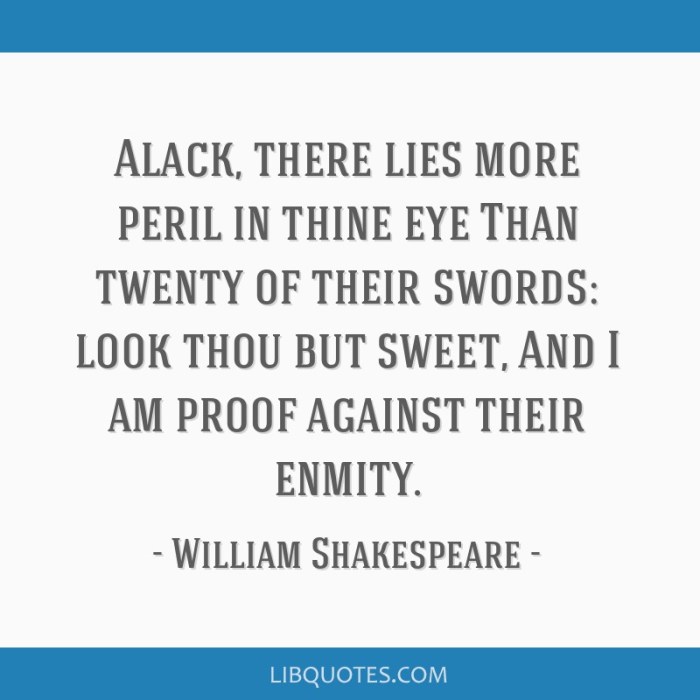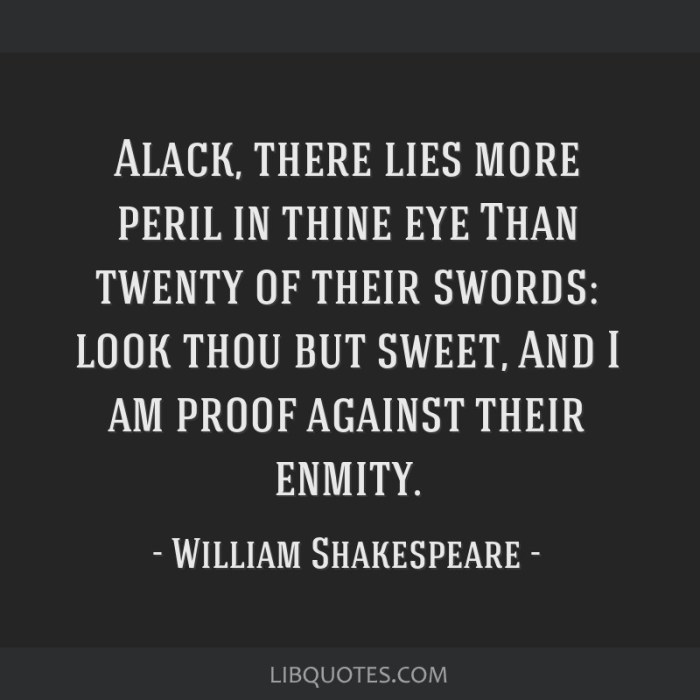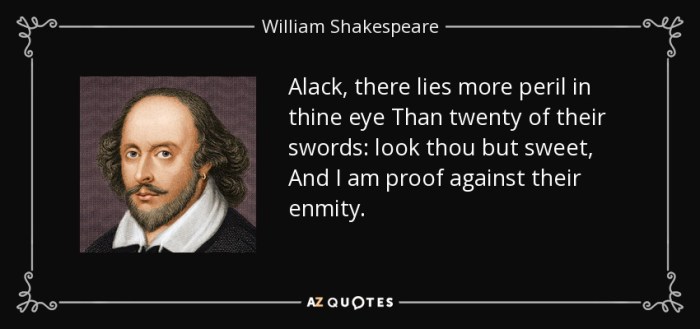Alack there lies more peril – Alack, there lies more peril, a phrase steeped in literary tradition, beckons us into a realm of hidden dangers and ominous foreshadowing. From its etymological roots to its modern interpretations, this phrase has captivated writers and readers alike, leaving an enduring mark on the literary landscape.
Throughout history, “alack, there lies more peril” has served as a potent literary device, heightening tension, foreshadowing impending doom, and shaping character development. Its versatility has allowed it to transcend genres, appearing in works from Shakespeare to contemporary thrillers.
Contextual Exploration
The phrase “alack there lies more peril” expresses a sense of impending danger or misfortune. It often appears in literary works to create a sense of foreboding or suspense.
The phrase is commonly found in works of classic literature, such as Shakespeare’s plays. For example, in Romeo and Juliet, the character Friar Laurence warns Romeo of the dangers of his love for Juliet, saying, “Alack, there lies more peril in thine eye / Than twenty of their swords.”
Alack, there lies more peril in life than we can ever imagine. Just like the zig and zag crossword clue , which requires us to think laterally to solve it, life often throws us curveballs that we must navigate with cunning and resilience.
And so, we must always be prepared for the unexpected and embrace the challenges that come our way.
This line foreshadows the tragic events that are to come.
Examples of Effective Usage
The phrase “alack there lies more peril” can be used effectively in a variety of literary genres, including:
- Tragedy:To foreshadow impending doom or misfortune.
- Suspense:To create a sense of tension and anticipation.
- Horror:To evoke a feeling of dread or fear.
By using this phrase, authors can create a powerful emotional impact on their readers.
Etymological Origins

The phrase “alack there lies more peril” traces its roots back to the Middle English period. It emerged as an exclamation expressing dismay or concern, often used to convey a sense of impending danger or adversity.
Historical Evolution
In its earliest usage, the phrase was employed in literary works, particularly in plays and poems, to heighten dramatic tension and evoke emotions of foreboding and uncertainty. Over time, it became incorporated into everyday speech, serving as an interjection to express feelings of apprehension or alarm.
Cultural and Linguistic Influences
The phrase’s cultural and linguistic influences are multifaceted. It draws upon the Germanic root word “alack,” meaning “alas” or “woe,” which conveys a sense of distress or sorrow. The word “peril,” derived from the Latin “periculum,” signifies danger or risk.
Together, these elements create a potent expression that encapsulates the anticipation of impending trouble.
Connotations and Implications: Alack There Lies More Peril

The phrase “alack there lies more peril” carries a somber and foreboding tone. It conveys a sense of impending danger and a warning that something terrible is about to happen.
The word “alack” is an interjection that expresses grief or dismay. It suggests that the speaker is deeply troubled by the situation at hand. The word “peril” refers to a serious danger or threat. When these two words are combined, they create a powerful image of a perilous situation that is likely to cause harm.
Nuances and Subtleties
The phrase “alack there lies more peril” can be used in a variety of contexts, each with its own unique set of nuances and subtleties.
- In a literary context, the phrase might be used to foreshadow an upcoming tragedy. It could also be used to create a sense of suspense or to build tension.
- In a historical context, the phrase might be used to describe a dangerous situation, such as a battle or a natural disaster. It could also be used to warn people of a potential threat.
- In a personal context, the phrase might be used to express concern or worry about a loved one. It could also be used to describe a difficult situation that the speaker is facing.
The meaning of the phrase “alack there lies more peril” can also vary depending on the tone of voice used by the speaker. For example, the phrase could be spoken in a serious or a sarcastic tone. The tone of voice will affect the way that the phrase is interpreted.
Psychological Impact
The phrase “alack there lies more peril” can have a powerful psychological impact on the listener. It can create a sense of fear, anxiety, or even panic. The phrase can also lead to feelings of helplessness or hopelessness.
In some cases, the phrase “alack there lies more peril” can be used to manipulate people. For example, a politician might use the phrase to scare people into voting for them. A salesperson might use the phrase to convince people to buy a product.
It is important to be aware of the potential psychological impact of the phrase “alack there lies more peril” before using it. The phrase should only be used in a responsible manner.
Literary Analysis
The phrase “alack there lies more peril” is a powerful literary device that creates tension and foreshadowing in works of literature. It serves as a warning, hinting at impending danger or obstacles that the characters will face.
By foreshadowing potential threats, the phrase heightens the reader’s anticipation and suspense. It creates a sense of unease, as the reader is aware that the characters’ journey will not be without its challenges.
Impact on Character Development and Plot Progression
- Character Development:The phrase can influence character development by revealing their fears, vulnerabilities, and motivations. As characters confront the perils hinted at by the phrase, they may grow, adapt, and overcome obstacles, leading to significant character arcs.
- Plot Progression:The phrase can drive plot progression by introducing unexpected twists and turns. It can set up conflicts, obstacles, and challenges that the characters must navigate, shaping the overall direction of the story.
Role in Shaping Tone and Atmosphere
- Tone:The phrase can establish a tone of foreboding, warning, or suspense. It creates a sense of impending doom or danger, immersing the reader in an atmosphere of uncertainty and anticipation.
- Atmosphere:The phrase can contribute to the overall atmosphere of a work. It can evoke a sense of mystery, intrigue, or fear, enhancing the reader’s emotional connection to the story.
Modern Interpretations

The phrase “alack there lies more peril” has transcended its original literary context and found resonance in contemporary discourse. It captures the sense of lurking danger or unexpected challenges that can arise in various aspects of modern life.
In current events, the phrase is often used to highlight the hidden risks associated with technological advancements, social media, and geopolitical tensions. For instance, the rise of artificial intelligence has raised concerns about potential job displacement and ethical dilemmas, leading commentators to caution “alack there lies more peril” in unbridled technological progress.
Social Issues
The phrase also resonates in discussions surrounding social issues. It draws attention to the subtle but pervasive dangers faced by marginalized communities, such as discrimination, prejudice, and systemic inequalities. Activists use the phrase to underscore the need for vigilance and collective action to address these hidden perils.
Personal Experiences
Beyond its application to broader societal issues, “alack there lies more peril” finds relevance in personal experiences as well. It acknowledges the unforeseen challenges and obstacles that can arise in our daily lives. From navigating interpersonal relationships to pursuing career aspirations, the phrase serves as a reminder to approach situations with caution and be prepared for unexpected turns.
Adaptations and Reinterpretations, Alack there lies more peril
The phrase has also been adapted and reinterpreted in various forms of modern art and literature. In literature, authors have employed it to create suspense, foreshadow danger, or explore themes of vulnerability and resilience. In music, the phrase has inspired song lyrics and album titles, evoking a sense of foreboding or a call to action.
Artistic Representation

The phrase “alack there lies more peril” has been visually depicted in various art forms, capturing its essence through symbolism and evocative techniques.
The table below showcases examples of artistic representations of the phrase, organized by artistic style, period, or medium:
Paintings
- “The Perils of the Night” (1863) by Dante Gabriel Rossetti: A haunting painting depicting a woman gazing out a window at a shadowy figure, symbolizing the lurking dangers of the night.
- “The Fall of Icarus” (c. 1560) by Pieter Bruegel the Elder: A serene landscape with a tiny figure of Icarus falling from the sky, conveying the perils of hubris and ambition.
Sculptures
- “Laocoön and His Sons” (c. 200-100 BC): A Hellenistic sculpture depicting the Trojan priest Laocoön and his sons being strangled by sea serpents, representing the futility of resisting fate.
- “The Thinker” (1904) by Auguste Rodin: A bronze sculpture of a man contemplating his existence, embodying the existential perils of human life.
Other Forms of Art
- “The Raven” (1845) by Edgar Allan Poe: A poem that uses vivid imagery and symbolism to explore the themes of loss, despair, and the perils of obsession.
- “The Masque of the Red Death” (1842) by Edgar Allan Poe: A short story that depicts a group of wealthy aristocrats attempting to escape the plague, only to meet a gruesome end, symbolizing the futility of trying to evade destiny.
FAQ Corner
What is the origin of the phrase “alack, there lies more peril”?
The phrase traces its roots back to the Middle English period, where “alack” expressed grief or dismay, while “peril” denoted danger or hazard.
How has the meaning of “alack, there lies more peril” evolved over time?
While its core meaning of impending danger remains, the phrase has acquired a sense of inevitability and foreboding, often hinting at a hidden or underestimated threat.
In what literary genres is the phrase commonly used?
The phrase finds its home in various genres, including tragedy, drama, horror, and even contemporary fiction, where it serves to create suspense and foreshadow future events.